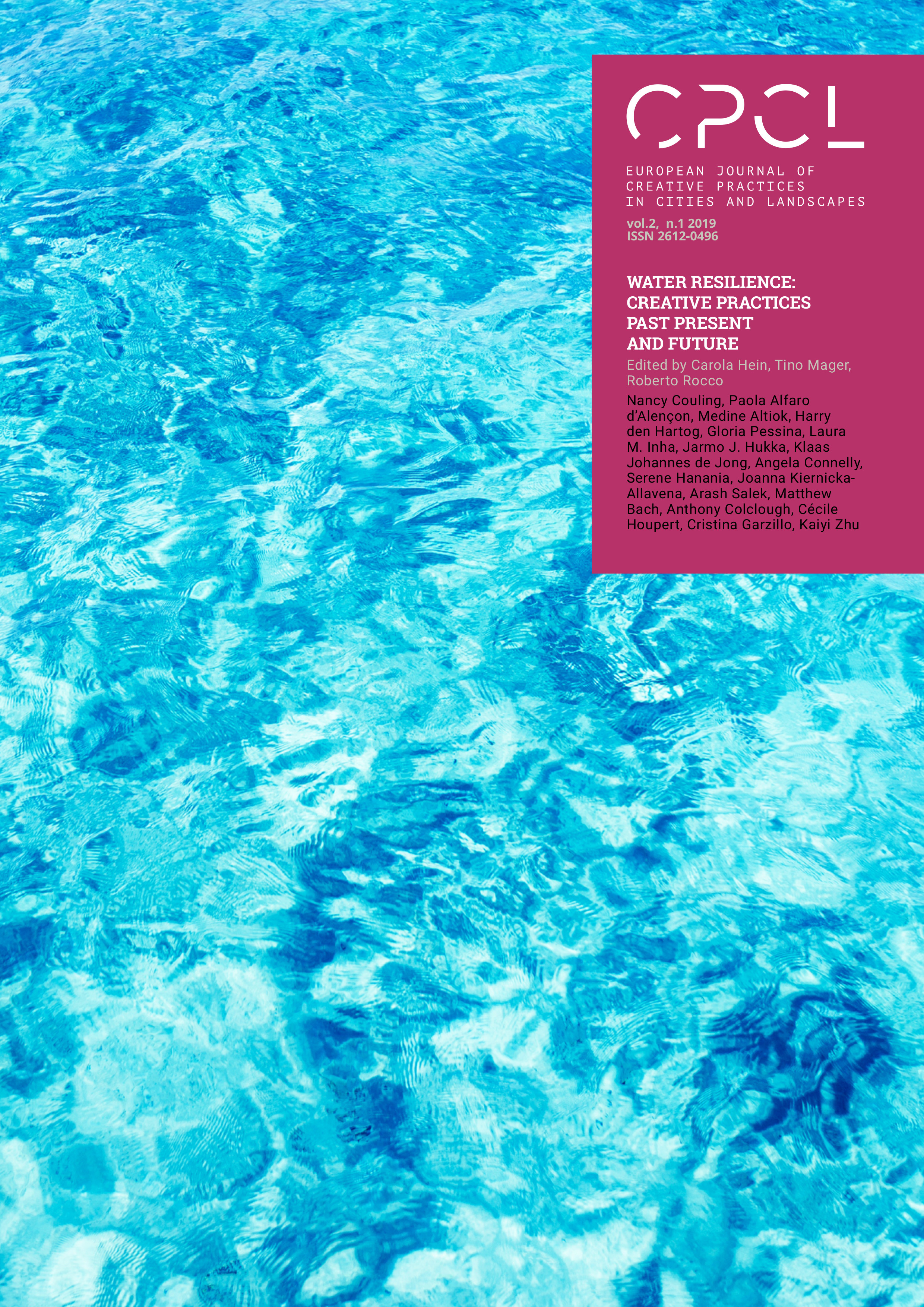Water as Source of Conflict and as a Vehicle for Peace
DOI:
https://doi.org/10.6092/issn.2612-0496/8687Keywords:
Water, Israeli-Palestinian Conflict, Conflict, Peace, Temple of WaterAbstract
Water accessibility in Israel and the Palestinian Territories is part of the politics in the Israeli-Palestinian conflict and contributes to the feeling of mistrust and misunderstanding between Israelis and Palestinians. This article explores the implications of access to water. It proposes an architectural design for a Temple of Water as a catalyst for dialogue and understanding between Israelis and Palestinians in the water-stressed region of Hebron on the southern West Bank. It aims to create a water space for social and communal practices as a vehicle for social interaction. Opportunities for peaceful coexistence are needed in conflict areas. The Temple of Water makes a statement about water’s power, meaning and influence. The research highlights the potential of spatial planning and design to promote either conflict or peaceful coexistence. Key specifications for architectural projects in water-stressed and conflict-ridden spaces have been defined with a theoretical framework concerning the value and implications of water in Israel and Palestine. The research takes a step towards understanding the power, meaning and influence that water can have through its physical embodiment in an architectural artefact.
References
Berck, Peter and Jonathan Lipow. “Real and Ideal Water Rights: The Prospects for Water-Rights Reform in Israel. Gaza and the West Bank.” Resource and Energy Economics 16, no. 4 (1994): 287-301. https://doi.org/10.1016/0928-7655(94)90022-1
B’Tselem. The Gap in Water Consumption between Palestinians and Israelis. Accessed February 18, 2019. https://www.btselem.org/gap-water-consumption-between-palestinians-and-israelis.
Cooley, John K. “The War over Water.” Foreign Policy 54 (1984): 3-26. https://doi.org/10.2307/1148352
Curti, Giorgio H. “From a Wall of Bodies to a Body of Walls: Politics of Affect | Politics of Memory | Politics of War.” Emotion, Space and Society 1, no. 2 (2008): 106-118. https://doi.org/10.1016/j.emospa.2009.02.002
Feitelson, Eran and Gad Rosenthal. “Desalination, Space and Power: The Ramifications of Israel's Changing Water Geography.” Geoforum 43, no. 2 (2012): 272-284. https://doi.org/10.1016/j.geoforum.2011.08.011
Finkelman, Ifat, Debora P. Fdeda, Sagiv Oren, and Tania C. Uzzielli, eds. In Statu Quo: Structures of Negotiation. Berlin: Hatje Cantz Verlag, 2018.
Gleick, Peter H. “Water and Conflict: Fresh Water Resources and International Security.” International Security 18, no. 1 (1993): 79-112. https://doi.org/10.2307/2539033
Jigyasu, Rohit. “Reinforcing the Link between Water and Heritage in Order to Build Disaster Resilient Societies.” In Water & Heritage: Material, Conceptual and Spiritual Connections, edited by Willem Willems, and Henk Van Schaik. Leiden: Sidestone Press, 2015.
Kuepper, Fred. “The Impacts of Relying on Desalination for Water.” Scientific American. Accessed March 16, 2019. https://www.scientificamerican.com/article/the-impacts-of-relying-on-desalination/
Larkin, Craig. “Remaking Beirut: Contesting Memory, Space, and the Urban Imaginary of Lebanese Youth.” City & Community 9, no. 4 (2010): 414-442. https://doi.org/10.1111/j.1540-6040.2010.01346.x
Mi'Ari, Mahmoud. “Attitudes of Palestinians Toward Normalization with Israel.” Journal of Peace Research 36, no. 3 (1999): 339-348. https://doi.org/10.1177/0022343399036003006
Müller, Patrick. Occupation in Hebron. The Alternative Information Center: Jerusalem, 2004.
Najjar, Jennifer. “Water: A Potential Vehicle For Peace?.” University of Denver Water Law Review. 2019. Accessed November 15, 2018. http://duwaterlawreview.com/water-a-potential-vehicle-for-peace-2/.
Newman, David. “Shared Spaces - Separate Spaces: the Israel-Palestine Peace Process.” GeoJournal. 39, no. 4 (1996): 363-375. https://www.jstor.org/stable/41146953
Ostrom, Elinor. Governing the Commons. The Evolution of Institutions for Collective Action. Cambridge: Cambridge University Press, 1990.
Schrum, Randy. The Hydro-Apartheid of Palestinian Communities in Israel. Accessed November 15, 2018. https://anydisaster.com/hydro-apartheid-palestinian-communities-israel.
Shoshan, Malkit, and Joost Grootens. Atlas of the Conflict: Israel-Palestine. Rotterdam: 010 Publishers, 2010.
United Nations. Water Resources of the Occupied Palestinian Territory. New York, 1992.
Walters, Derk. “Nooit Was Het Zo Erg in Hebron, Microkosmos van de Bezetting.” NRC Handelsblad. 2016. Accessed November 15, 2018. https://www.nrc.nl/nieuws/2016/01/12/zo-erg-was-het-nooit-in-hebron-1579725-a1168766.
Weizman, Eyal. “Scenography.” In In Statu Quo: Structures of Negotiation, edited by Ifat Finkelman, Debora P. Fdeda, Sagiv Oren and Tania C. Uzzielli, 185-230. Berlin: Hatje Cantz Verlag, 2018.
Willems, Willem J. H. and Van Schaik, Henk P. J., ed. Water & Heritage: Material, Conceptual and Spiritual Connections. Leiden: Sidestone Press, 2015.
Zahra, Bader A. A. A. “Water Crisis in Palestine.” Desalination. 136, no. 1–3 (2001): 93-99. https://doi.org/10.1016/S0011-9164(01)00169-2.
Published
How to Cite
Issue
Section
License
Copyright (c) 2019 Klaas Johannes de Jong
Copyrights and publishing rights of all the texts on this journal belong to the respective authors without restrictions.This journal is licensed under a Creative Commons Attribution 4.0 International License (full legal code).
See also our Open Access Policy.





